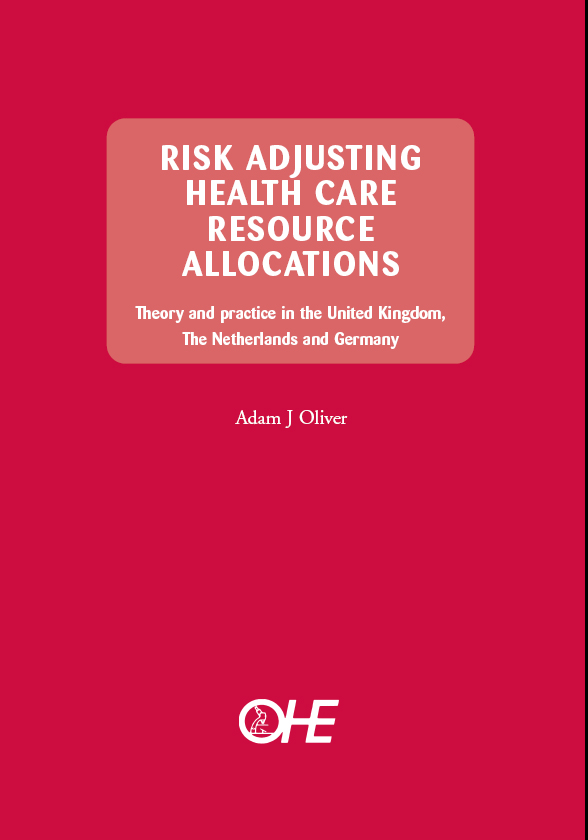Sign up to our newsletter Subscribe
Analysing Global Immunisation Expenditure

Most health care systems are characterised by both purchasers (insurers, health authorities), who buy health care for a particular population, and providers (hospitals, primary care physicians), who supply health care services. In circumstances where the purchasers or providers bear any of the financial…
Most health care systems are characterised by both purchasers (insurers, health authorities), who buy health care for a particular population, and providers (hospitals, primary care physicians), who supply health care services. In circumstances where the purchasers or providers bear any of the financial risk associated with covering a population, incentives to prefer to ‘risk select’ are present; i.e. purchasers will prefer to provide cover for people who are likely to require relatively little health care. In order to reduce these incentives to risk select, many countries have introduced risk adjustment mechanisms.
Van de Ven and Ellis (1999) have defined risk adjustment as ‘the use of information to calculate the expected health expenditures of individual consumers over a fixed interval of time (e.g., a month, quarter, or year) and set subsidies to consumers or health plans to improve efficiency and equity’. However, Van de Ven and Ellis are concerned only with competitive health plan markets. In the current monograph, the discussion of risk adjustment will be extended beyond competitive health plan markets, to include National Health Service (NHS)-type systems.
Within an NHS-type system, the principal purchasers of health care are non-competing health authorities (or their equivalents), fully responsible for a regionally defined population. The health authorities are allocated an annual budget from central government funds, and are required to purchase health care for everybody within their area of jurisdiction. The health authorities are government agencies, and do not bear any financial risk. Therefore, there is no incentive for them to risk select. However, there is likely to be a large degree of diversification concerning the demographic and socio-economic structure of the numerous regionally defined populations within any particular country. Therefore, on grounds of fairness, or equity, it may be appropriate for government to adjust the resource allocations to health authorities on the basis of population characteristics that proxy health care need.
Throughout this monograph, it is assumed that a person is in need of health care if they would experience an improvement in their health status on receiving further health care. As stated above, Van de Ven and Ellis’ definition that risk adjustment is ‘the use of information to calculate the expected health expenditures of individual consumers over a fixed interval of time … and set subsidies to consumers or health plans to improve efficiency and equity’, is applicable specifically to competitive insurance systems where the aim is to remove the incentives to risk select. In this monograph, the definition is broader, namely: ‘the use of information to calculate the expected health expenditures or health care need of individual consumers over a fixed interval of time … and set subsidies to consumers or health plans to improve efficiency and equity’, in order to accommodate considerations of equity in NHS-type systems.
Thus, there are two principal reasons why a government may want to introduce a risk adjustment mechanism into the health care financing system, with the specific reason being largely a function of the structure of the health care system:
(i) To promote some form of equity that accounts for the fact that people have differential levels of health care need.
(ii) To discourage risk selecting activity.
In this monograph, the principle of equity that was the stated motivation for introducing risk adjustment in England is outlined. Also, the reasons why it is considered important to discourage risk selecting, and how risk adjustment may achieve this, are detailed. An in-depth description of the mechanisms of all of the countries that have introduced risk adjustment is beyond the scope of this monograph. Moreover, the practical application of risk adjustment has been developing quite rapidly, and, consequently, published reports are soon dated. The author of this monograph had contact with people intrinsic to the practical application of risk adjustment in England, The Netherlands and Germany, which facilitated an up to date description of these systems at the time of writing. Thus, the health care financing structures and risk adjustment mechanisms currently in operation in England, The Netherlands and Germany, three European countries with a strong, historical commitment to providing good, universal health care coverage, are discussed.
The discussion is conducted with reference to the principal reasons for introducing risk adjustment in these respective countries. Finally, whether England, The Netherlands and Germany have anything to learn from each other with respect to risk adjustment, and how the various mechanisms might be improved, is considered.
Risk Adjusting Health Care Resource Allocations
Oliver, A.
(1999) Risk Adjusting Health Care Resource Allocations. OHE Monograph. Available from https://www.ohe.org/publications/risk-adjusting-health-care-resource-allocations/